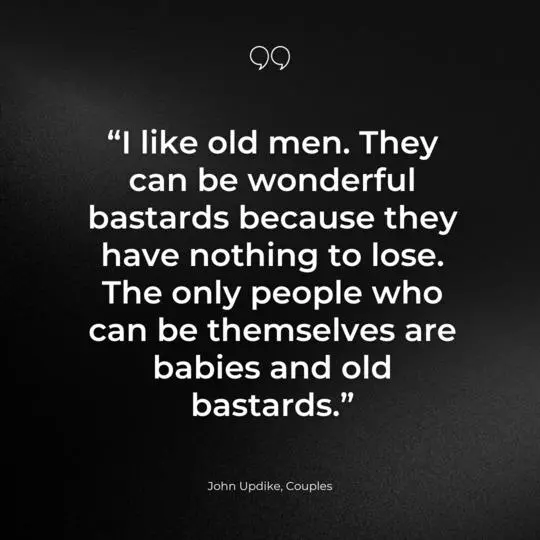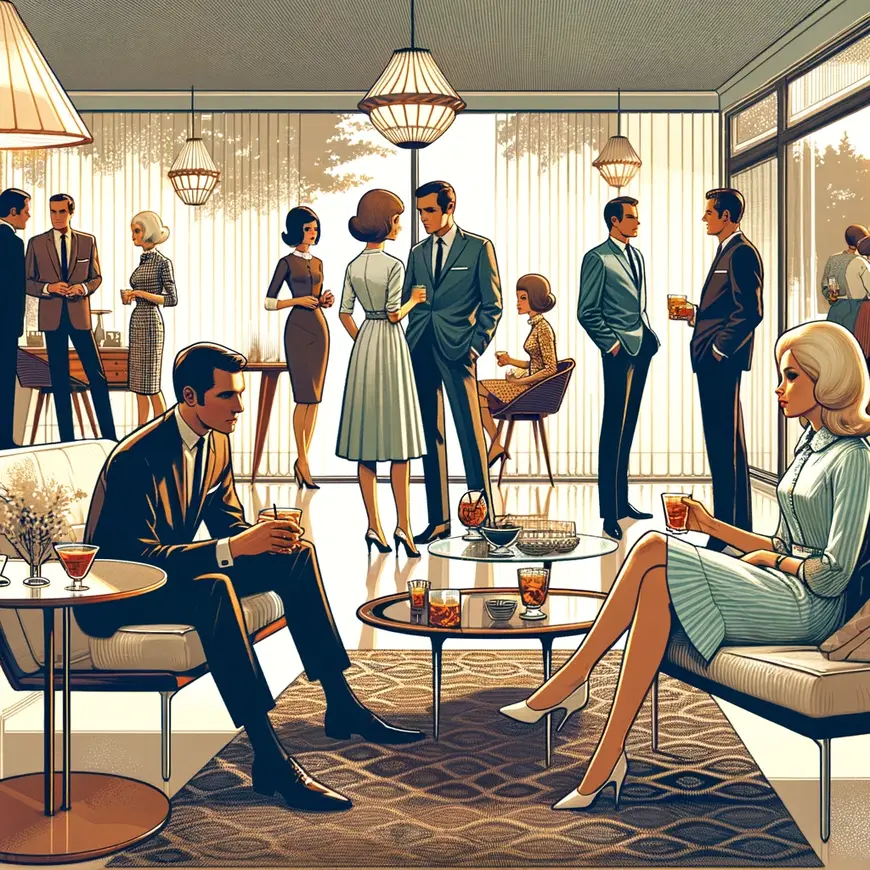Exploring Love and Struggles: A Deep Dive into “Couples” by John Updike
My Take Aways from Couples by John Updike
Reading “Couples” by John Updike turned out to be a very interesting pilgrimage into the intricacies of personal relationships. Almost from the beginning, a thorough examination of the lives and love affairs of several married couples in a small Massachusetts town captured me by its vivid prose and psychological depth.
What is human? Updike’s uncanny ability to slice into human emotions and social interactions so cleanly gave me pause for great reflection on the nature of commitment and desire. The characters maneuvered through their own mire of complications and betrayals, and one is judging them at one moment and sympathizing with their position at the next.
If the book could sound so candid about sexual and emotional entanglements to the extent of being bold and sometimes uncomfortably voyeuristic in its descriptions, it was this brutally frank voice that kept my attention and brought the thought of ethical vileness in my own relationships. By the end of “Couples,” I felt that I had a better, more informed understanding of the fragility and resilience of love in the modern world.
“Couples” by American Author John Updike is a captivating novel that delves into the intricate dynamics of love, desire, and relationships within a suburban community. Set against the backdrop of the 1960s, this novel takes readers on an emotional rollercoaster through the lives of ten couples, exposing their joys, conflicts, and vulnerabilities. With rich character development and a keen exploration of human nature, Updike weaves a tale that resonates with readers across generations.
The Suburban Tapestry and Exploration of Love
The novel unfolds in the fictional town of Tarbox, Massachusetts, where ten couples navigate the complexities of their relationships. Updike masterfully captures the essence of suburban life during the 1960s, painting a vivid picture of its norms, values, and societal expectations. Through the characters’ interactions, the author exposes the cracks beneath the picture-perfect facades, revealing the underlying tensions and suppressed desires that characterize their lives.
At its core, “Couples” is an exploration of love in its myriad forms. Updike presents a spectrum of relationships, ranging from passionate to strained. The characters’ experiences reflect the diversity of love – from the intoxicating rush of newfound passion to the bittersweet struggles of long-term commitment. By delving into the emotional landscapes of these couples, the novel highlights the universal themes of connection, intimacy, and the constant negotiation of individual needs within a partnership.
Characters’ Gallery: John Updike’s “Couples”
The novel introduces readers to a rich array of characters, each with their own distinct personalities and struggles. Harold and Foxy, a couple exploring an open marriage, challenge traditional notions of fidelity. Piet and Angela grapple with the confines of parenthood and the yearning for their lost youth. Updike masterfully crafts characters like these, with their flaws and insecurities, making them relatable and real.
Central to “Couples” is the theme of desire and its consequences. The characters’ desires often lead them to question the boundaries of their relationships. Infidelity becomes a recurring motif, showcasing the characters’ vulnerability to temptation and the subsequent impact on their emotional well-being. Updike’s portrayal of these conflicts reveals the fragility of human relationships and the complexities of staying true to one’s commitments.
Sexuality and Liberation
The 1960s was a time of shifting attitudes toward sexuality and liberation. Updike captures this cultural transformation through the characters’ exploration of their sexual desires. As the sexual revolution challenges traditional norms, the couples in the novel find themselves grappling with newfound freedoms and the pressures of conformity. Through their experiences, the novel offers a window into the changing dynamics of intimacy and personal identity during this era.
Updike’s characters are far from perfect, and their flaws make them all the more human. The novel delves deep into the emotional turmoil faced by the couples as they confront their insecurities, fears, and past traumas. Whether it’s Piet’s struggle with his self-worth or Foxy’s search for authenticity, the characters’ vulnerability resonates with readers, reminding them of their own inner battles.
Beneath the glossy veneer of suburban life lies a web of secrets and insecurities. The novel challenges the notion of perfection often associated with the suburban ideal. Updike peels back the layers, exposing the characters’ private struggles that contrast sharply with their outward appearances. This contrast serves as a commentary on the façade many people maintain to fit societal expectations, highlighting the tension between authenticity and conformity.

Impact of Communication
Communication, or the lack of it, plays a pivotal role in the novel’s relationships. The couples struggle to express their feelings and desires. This often leads to misunderstandings and conflicts. Updike’s exploration highlights communication’s importance in nurturing healthy relationships. It also shows how poor communication can exacerbate tensions.
“Couples” delves into the personal lives of its characters. It also offers a broader social and cultural commentary. The novel reflects the changing values and norms of the 1960s. It explores the evolving role of women and the impact of technological advancements on daily life. These elements enrich the narrative. They situate the characters within a larger historical context.
In “Couples,” John Updike creates a tapestry of human relationships. The story is both timeless and timely. Through the lives of ten couples, he delves into love, desire, and the pursuit of happiness. The novel explores suburban life in the 1960s. It combines rich character development and thematic depth and then it continues to captivate readers. It offers insights into the universal challenges of navigating love and human connection.
Unveiling Desires and Dissatisfaction: Decoding the Impact of “Couples” by John Updike
John Updike’s novel “Couples” delves into human relationships. It exposes raw desires, complexities, and shortcomings. The story is set in a suburban community during the 1960s. The book unearths the struggles faced by ten couples. They grapple with love, infidelity, and personal fulfillment.
At its core, “Couples” explores human desire and its consequences. The characters’ emotional and physical desires drive the narrative. These desires make them question the boundaries of their relationships. The novel shows how desires can enrich and corrode connections. It highlights the balance between personal fulfillment and partnership commitments.
The book offers a candid look into simmering dissatisfaction. The suburban setting, linked to domestic bliss, becomes a stage for discontent. Updike peels back the layers of their lives. He uncovers the gap between appearances and reality. He illustrates the limitations of conforming to societal norms and expectations.
Impact on Literary Critics: John Updike’s “Couples”
“Couples” elicited a diverse range of responses from literary critics. Some praised Updike’s skillful portrayal of complex characters and the authenticity of their emotions. The vividness of the suburban setting and the exploration of taboo subjects, such as infidelity and sexual liberation, garnered attention and discussion. Critics lauded Updike’s ability to capture the nuances of human desires and the intricacies of relationships, acknowledging the depth and realism of his narrative.
However, the novel also sparked controversy. Some critics criticized the characters’ self-indulgence and questioned the novel’s treatment of women, suggesting that some female characters were reduced to mere reflections of male desires. The explicit nature of the novel’s content also polarized opinions, with some finding it a bold reflection of changing societal norms, while others considered it gratuitous.
Impact on Society:
“Couples” had a significant impact on society in the 1960s. The book explored sexual liberation and changing relationships. It resonated with the cultural shifts of that era. The novel mirrored the growing emphasis on personal freedom. It questioned traditional norms. This contributed to the dialogue about changing roles of men and women in society.
The depiction of suburban dissatisfaction challenged idealized suburban life. It invited readers to question the pursuit of material comfort. It also questioned societal conformity. This resonated with a generation reevaluating its values. They sought authenticity in a rapidly changing world.
“Couples” was a reflection of its time. However, its exploration of universal themes ensured lasting relevance. The characters struggle to balance individual desires with relationship demands. This continues to strike a chord with readers in different eras. The novel’s candid examination of human nature confronts taboo subjects. It paved the way for future literary works exploring similar themes.

Notable quotes from “Couples” by John Updike:
- Quote: “If men are so lecherous, women so patient, men so doubting, women so faithful, men so quick, women so slow, men so brutal, women so tender – what is the truth?” Summary: This quote reflects the complex interplay of gender dynamics and questions traditional stereotypes. It highlights the contradictions and contrasts between men and women’s behaviors and challenges societal norms and expectations.
- Quote: “Lust was another of the endless distractions that went on all day long in the streets of Tarbox.” Summary: This quote encapsulates the pervasive nature of desires and distractions in the suburban setting of Tarbox. Lust, along with other desires, serves as a continuous undercurrent that impacts the lives of the characters throughout the novel.
- Quote: “She would need a man to take care of her, yet all men seemed to want from her was sex.” Summary: This quote reflects the internal conflict of a female character who grapples with societal expectations and her own desires. It highlights the challenge of finding a balance between personal needs and the external pressures placed on women.
- Quote: “Love was a terrible thing and a marvelous thing.” Summary: This quote captures the dual nature of love – both its beauty and its complexity. It portrays the conflicting emotions and experiences that come with love, emphasizing the simultaneous joy and pain it can bring.
- Quote: “He was no longer Piet and she no longer Angela; they were something quite strange, almost enemies.” Summary: This quote depicts the erosion of intimacy and connection within a relationship. It illustrates how familiarity can breed distance, transforming once-close partners into strangers as the dynamics of the relationship change.
These summaries highlight some of the key themes and insights found within “Couples” by John Updike.
Conclusion: John Updike’s “Couples”
John Updike’s “Couples” remains a thought-provoking exploration of human relationships, desires, and societal norms. Its impact on literary critics and society at large demonstrates its ability to spark conversations about love, discontent, and the complexities of the human experience. By delving into the depths of characters’ hearts and minds, “Couples” invites readers to reflect on their own desires and relationships, reminding us that beneath the veneer of normalcy lies a world of unspoken longings and hidden complexities.
Reviews of other Works by John Updike
Into Shakespearean Lore: Exploring “Gertrude and Claudius” by John Updike My Thoughts on Gertrude and Claudius by John Updike”Gertrude and…
“The Witches of Eastwick” by John Updike: A Bewitching Blend of Fantasy and Feminism John Updike’s “The Witches of Eastwick”…
A Riveting Tale of Ambition, Love, and Midlife Reflection – John Updike’s “Rabbit Is Rich” Dive into the enthralling world…
An Intense Journey of Personal Turmoil – “Rabbit Redux” by John Updike John Updike, the celebrated American novelist, takes readers…
John Updike Rabbit, Run: An Exploration of Existential Turmoil and Suburban Discontent My Thoughts on Rabbit, Run by John Updike…




